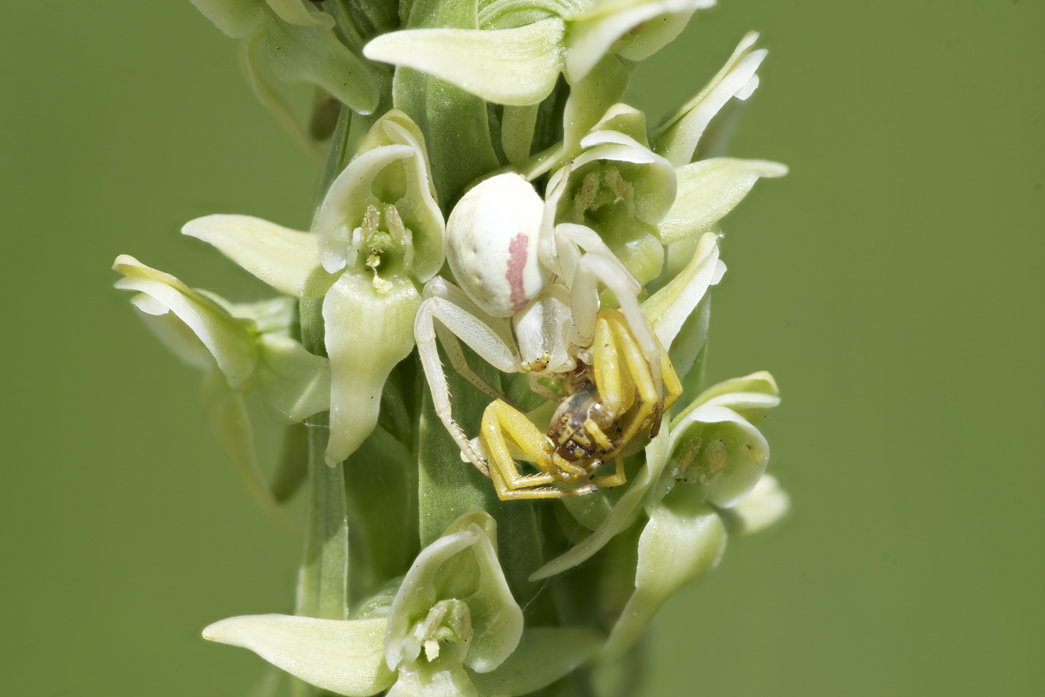
Yellowstone is home to several species of orchids. One of the most common in moist areas is the bog orchid.
My husband loves to photograph flowers. After he took several pictures of some bog orchids he blew one of them up in Photoshop to see how well focused it was. When he did he found he had taken a picture of a white and pink tiny spider he didn’t even know was on the orchid. We weren’t very far from where he took the photo, near Warm Springs Picnic Area in the northeast corner of the park, so we went back. He found the flower and the spider, but by the time he got back the spider had caught dinner, the yellow spider you see in the close up of the orchid plant at the end of this post.

After we got home he looked up the spiders and found that both the white one and the yellow one were the same species of crab spider, a flower or goldenrod crab spider, Misumena vatia.
One of the more interesting relationships exists between spiders and flowers. Since pollinators are essential to the flowers, anything that decreases those pollinators is detrimental to the plants, so the relationship is a sort of parasitism, not like a tick on a dog, but an interaction that benefits the spider and indirectly harms the flower.
Some spiders camouflage themselves, to avoid detection by their insect prey, and can match the color of the flower they hide on. The flower crab spider, or goldenrod crab spider, is yellow on goldenrods and other yellow composites, but can change to white when on white flowers. The change from white to yellow takes 10-20 days, but the spider can excrete the yellow dye and change back to white in six or so days.
The way this crab spider changes color is totally different than the way animals such as true chameleons and anole lizards change color. (Please note: If you like a little mystery in your life don’t read the rest of this paragraph. I say that because when I was a kid I used to marvel at the way anole lizards changed color. Later I majored in biology and found out how they do it and I have to say I was disappointed. It wasn’t magic anymore!) Some lizards have a variety of pigment cells in their skin. Some of the cells, chromatophores contain melanin, a dark brown pigment. Some contain green pigments. When a lizard feels a certain way, not when he is on a particular color, his nervous system causes some cells to expand and others to contract and he turns green. When his emotions change (can I use the word “emotions” about lizards?) the green cells contract and the dark brown ones expand. Magic!!
Lizards don’t see the color they are on but crab spiders do. When they land on a yellow flower they start producing a yellow pigment, but it takes them days to do it. If they land on a white flower they see white and begin destroying the yellow pigment. This has been proven. When biologists blinded the spiders they lost their ability to change color. That makes we wonder where they got the tiny blindfolds.
One of Yellowstone’s bog orchids is greenish white. The photo below is of a tiny, 10 mm long white crab spider, well camouflaged on the white orchid, eating a yellowish, not so well camouflaged version of the same species. Hey that’s cannibalism isn’t it? It also is a lesson to us all that the closer we look the more we see.

A White Crab Spider Eating a Yellow Crab Spider on a Bog Orchid






Good lesson and a wonderful set of images.
Fascinating capture! The ones I’ve seen here in Colorado look a lot more crab like.
The ones in Texas do to Penelope.